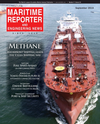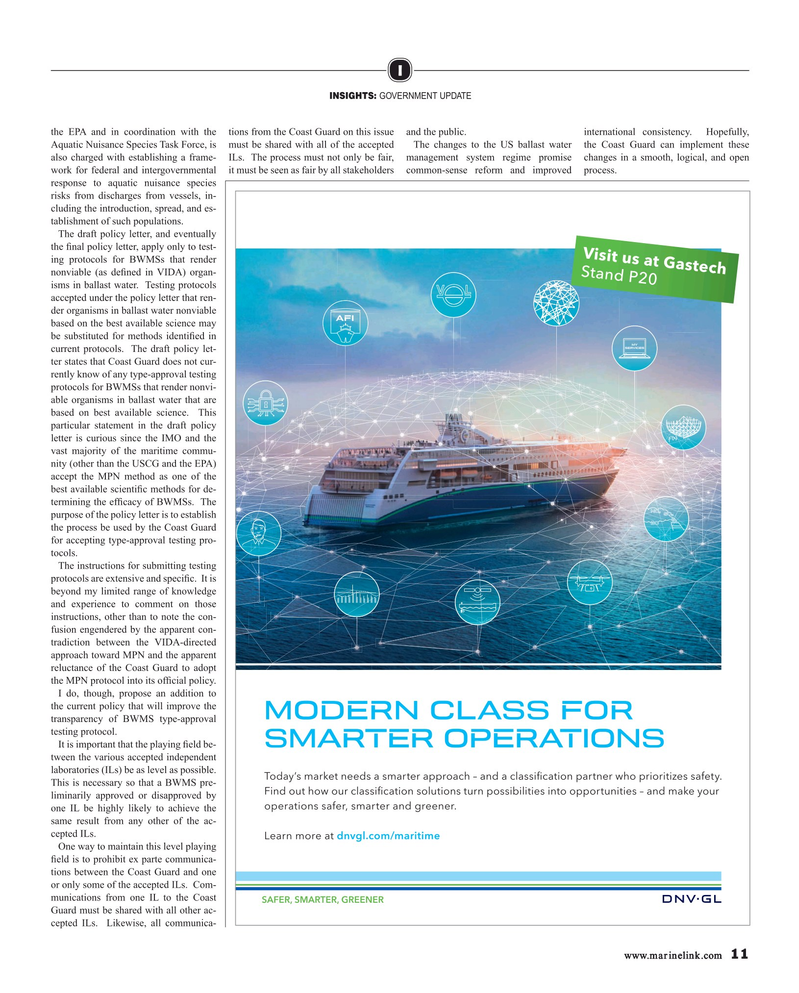
Page 11: of Maritime Reporter Magazine (September 2019)
Satellite Communications
Read this page in Pdf, Flash or Html5 edition of September 2019 Maritime Reporter Magazine
I
INSIGHTS: GOVERNMENT UPDATE the EPA and in coordination with the tions from the Coast Guard on this issue and the public. international consistency. Hopefully,
Aquatic Nuisance Species Task Force, is must be shared with all of the accepted The changes to the US ballast water the Coast Guard can implement these also charged with establishing a frame- ILs. The process must not only be fair, management system regime promise changes in a smooth, logical, and open work for federal and intergovernmental it must be seen as fair by all stakeholders common-sense reform and improved process. response to aquatic nuisance species risks from discharges from vessels, in- cluding the introduction, spread, and es- tablishment of such populations.
The draft policy letter, and eventually the ? nal policy letter, apply only to test-
Visit us at Gastech ing protocols for BWMSs that render nonviable (as de? ned in VIDA) organ-
Stand P20 isms in ballast water. Testing protocols accepted under the policy letter that ren- der organisms in ballast water nonviable based on the best available science may be substituted for methods identi? ed in current protocols. The draft policy let- ter states that Coast Guard does not cur- rently know of any type-approval testing protocols for BWMSs that render nonvi- able organisms in ballast water that are based on best available science. This particular statement in the draft policy letter is curious since the IMO and the vast majority of the maritime commu- nity (other than the USCG and the EPA) accept the MPN method as one of the best available scienti? c methods for de- termining the ef? cacy of BWMSs. The purpose of the policy letter is to establish the process be used by the Coast Guard for accepting type-approval testing pro- tocols.
The instructions for submitting testing protocols are extensive and speci? c. It is beyond my limited range of knowledge and experience to comment on those instructions, other than to note the con- fusion engendered by the apparent con- tradiction between the VIDA-directed approach toward MPN and the apparent reluctance of the Coast Guard to adopt the MPN protocol into its of? cial policy.
I do, though, propose an addition to the current policy that will improve the
MODERN CLASS FOR transparency of BWMS type-approval testing protocol.
SMARTER OPERATIONS
It is important that the playing ? eld be- tween the various accepted independent laboratories (ILs) be as level as possible.
Today’s market needs a smarter approach – and a classi?cation partner who prioritizes safety.
This is necessary so that a BWMS pre-
Find out how our classi?cation solutions turn possibilities into opportunities – and make your liminarily approved or disapproved by operations safer, smarter and greener. one IL be highly likely to achieve the same result from any other of the ac- cepted ILs.
Learn more at dnvgl.com/maritime
One way to maintain this level playing ? eld is to prohibit ex parte communica- tions between the Coast Guard and one or only some of the accepted ILs. Com- munications from one IL to the Coast
Guard must be shared with all other ac- cepted ILs. Likewise, all communica- www.marinelink.com 11
MR #9 (10-17).indd 11 MR #9 (10-17).indd 11 9/11/2019 8:59:03 AM9/11/2019 8:59:03 AM

 10
10

 12
12
